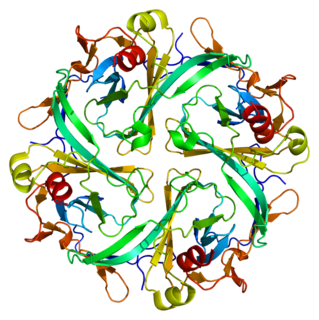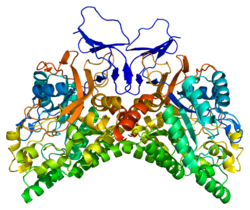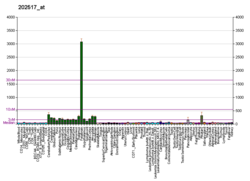
The Kir2.1 inward-rectifier potassium ion channel is a lipid-gated ion channel encoded by the KCNJ2 gene.

Ovarian cancer G-protein coupled receptor 1 is a protein that in humans is encoded by the GPR68 gene.

Neuronal acetylcholine receptor subunit beta-2 is a protein that in humans is encoded by the CHRNB2 gene.

Proto-oncogene tyrosine-protein kinase FER is an enzyme that in humans is encoded by the FER gene.

Dihydropyrimidinase-related protein 2 is an enzyme that in humans is encoded by the DPYSL2 gene.

Cyclin-dependent kinase 4 inhibitor D is an enzyme that in humans is encoded by the CDKN2D gene.

SWI/SNF-related matrix-associated actin-dependent regulator of chromatin subfamily D member 1 is a protein that in humans is encoded by the SMARCD1 gene.

Semaphorin-3F is a protein that in humans is encoded by the SEMA3F gene.

TNFAIP3-interacting protein 2 is a protein that in humans is encoded by the TNIP2 gene. TNIP2 contains multiple amino acid sites that are phosphorylated and ubiquitinated.

Chloride channel accessory 2 is a protein that in humans is encoded by the CLCA2 gene.

Dihydropyrimidinase-related protein 3 is an enzyme that in humans is encoded by the DPYSL3 gene.

Kinesin heavy chain isoform 5A is a protein that in humans is encoded by the KIF5A gene.

Sodium- and chloride-dependent glycine transporter 2, also known as glycine transporter 2 (GlyT2), is a protein that in humans is encoded by the SLC6A5 gene.

Calcium/calmodulin-dependent protein kinase kinase 2 is an enzyme that in humans is encoded by the CAMKK2 gene.

Kv channel-interacting protein 1 also known as KChIP1 is a protein that in humans is encoded by the KCNIP1 gene.

Mitochondrial uncoupling protein 4 is a protein that in humans is encoded by the SLC25A27 gene.

Dihydropyrimidinase-related protein 5 is an enzyme that in humans is encoded by the DPYSL5 gene.

Dihydropyrimidinase-related protein 4 is an enzyme that in humans is encoded by the DPYSL4 gene.

Dihydropyrimidinase is an enzyme that in humans is encoded by the DPYS gene.
Collapsin response mediator protein family or CRMP family consists of five intracellular phosphoproteins of similar molecular size and high (50–70%) amino acid sequence identity. CRMPs are predominantly expressed in the nervous system during development and play important roles in axon formation from neurites and in growth cone guidance and collapse through their interactions with microtubules. Cleaved forms of CRMPs have also been linked to neuron degeneration after trauma induced injury.
























